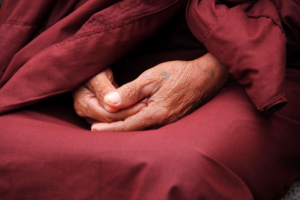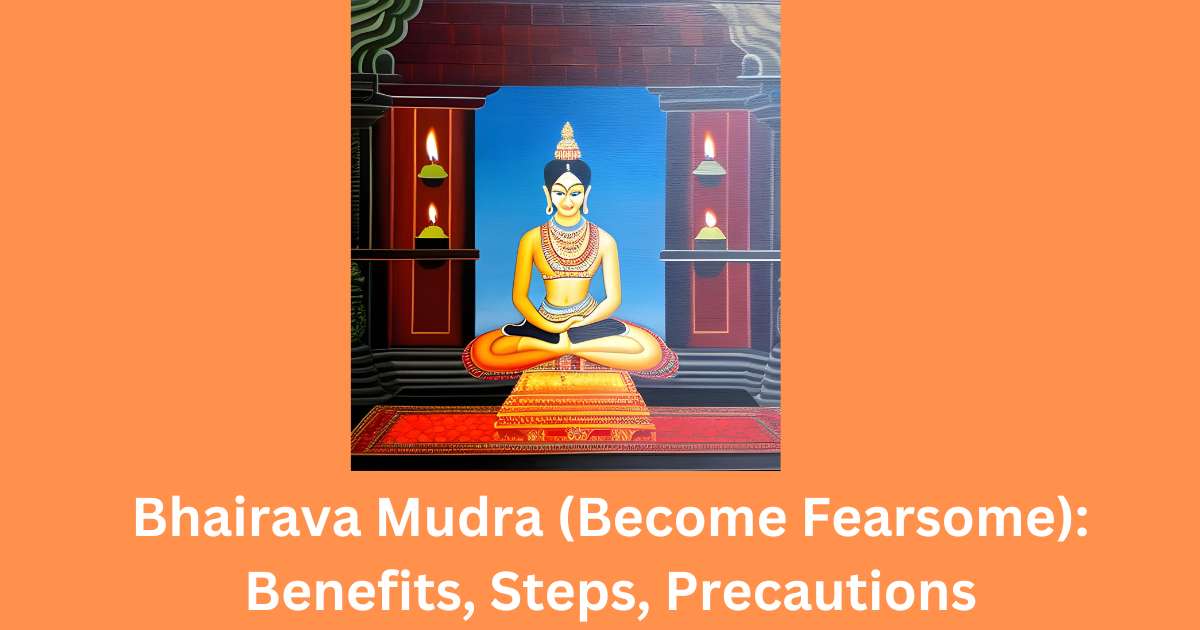Bhairava is a fearsome manifestation of Lord Shiva, representing the force that brings about the end of the universe. In the Bhairava mudra, the two hands symbolize the ida and pingala nadis, representing the union of the individual with the universal consciousness. This mudra is commonly practiced during pranayama and meditation, and is also a part of prana mudra.
What is Bhairavi Mudra?
Bhairavi Mudra is another hand gesture or seal that is similar to Bhairava Mudra. Bhairavi Mudra is also associated with the Hindu deity Bhairava, who represents the fierce and transformative aspect of Shiva. In this mudra, the right hand is placed over the left hand, with the palms facing up. The fingers of the right hand are interlaced with the fingers of the left hand, and the thumbs are pressed together. This mudra is believed to help balance the masculine and feminine energies within the body and cultivate a sense of inner harmony.
What are the benefits of Bhairava Mudra?
Bhairava Mudra is a hand gesture or seal that is believed to provide various physical, mental, and spiritual benefits. Some of the potential benefits of practicing Bhairava Mudra include:
- Reducing stress and anxiety: This mudra is believed to calm the mind and promote relaxation, which can help to reduce feelings of stress and anxiety.
- Boosting energy: It is said to help increase vitality and energy levels by balancing the flow of prana (life force energy) in the body.
- Enhancing focus and concentration: By activating specific energy points in the hands, this mudra is thought to improve mental clarity and concentration.
- Promoting inner strength: Itis associated with the Hindu deity Bhairava, who is often depicted as a fierce and powerful force. Practicing this mudra is said to help tap into this inner strength and cultivate courage and confidence.
How do you do Bhairava Mudra?
To practice Bhairava Mudra, follow these steps:
- Sit in a comfortable position with your spine straight and your hands resting on your knees or thighs.
- Bring your hands in front of your chest with your palms facing up.
- Bring your hands together so that the tips of your middle fingers touch.
- Bend your middle fingers and touch the tips of your thumbs to the tips of your middle fingers.
- Extend your ring fingers and little fingers outward.
- Hold the mudra for several minutes while focusing on your breath and the sensations in your body.

What precautions should be taken while practicing Bhairava Mudra?
Here are some precautions to keep in mind while practicing Bhairava Mudra:
- Practice this mudra under the guidance of a qualified yoga teacher.
- Individuals with a history of heart disease, hypertension, or any other serious medical conditions should consult their doctor before attempting this mudra.
- It’s important to maintain a relaxed and comfortable posture while practicing this mudra. Avoid any discomfort or strain in the body.
- Practitioners should focus on their breath while holding the mudra, ensuring that they are breathing slowly and deeply.
- Avoid practicing it immediately after eating.
- Do not overexert yourself while practicing this mudra. Listen to your body and take breaks if needed.
- If you experience any pain or discomfort while holding the mudra, release it immediately and consult with a yoga teacher or medical professional.
What is the difference between Bhairavi and Bhairava?
Bhairavi Mudra and Bhairava Mudra are two different mudras used in yoga practice. Bhairavi Mudra is a hand gesture that is performed with the left hand, while Bhairava Mudra is performed with the right hand. Here are some of the differences between the two mudras:
- Hand position: Bhairavi Mudra is formed by placing the left hand on the heart center, while Bhairava Mudra is formed by placing the right hand on the knee.
- Symbolism: Bhairavi Mudra is said to represent the goddess Shakti, who is associated with feminine energy and creativity. Bhairava Mudra, on the other hand, is said to represent the god Shiva, who is associated with masculine energy and power.
- Benefits: While both mudras are believed to have benefits for the mind and body, they are said to have slightly different effects. Bhairavi Mudra is thought to promote relaxation and calmness, while Bhairava Mudra is believed to increase energy and focus.
Overall, while Bhairavi and Bhairava may have different hand positions, symbolism, and benefits, they are both powerful tools for enhancing one’s yoga practice and connecting with deeper aspects of the self.
What are the benefits of Bhairava Mudra in Hindi?
भैरव मुद्रा योग में प्रयुक्त होने वाला एक हाथ का इशारा है जिसके कई फायदे होते हैं। इन फायदों में पाचन क्रिया में सुधार, चिंता और तनाव कम करना और समग्र ऊर्जा स्तर बढ़ाना शामिल हैं।
What are the benefits of Bhairava Mudra in Tamil?
தமிழில் பெயர் பூரண முத்திரை என்றும் அழைக்கப்படும் பைரவ முத்திரை யோகாவில் பயிற்சி செய்வதன் மூலம் நடக்கும் பலன்கள் உள்ளன. இவற்றின் பலன்கள் பெரியவர்களை பயன்படுத்தி வருகின்றன, மன சமாதானம் கொண்டு மனதில் உள்ள குறைவை கண்டிப்பாக்கும், மூட்டு பிடிக்கும் தருமங்களை நீக்குகின்றன, தூண்டும் குறைகளை அழுத்துகின்றன, மாதிரி குணங்களை உயர்த்துகின்றன, உடலில் உள்ள ஆரோக்கிய நிலை காக்கும்.
What are the benefits of Bhairava Mudra in Telugu?
Bhairava Mudra కి తెలుగులో ఏవిధంగా ప్రయోజనాలు ఉన్నాయివో తెలుసుకోవడం మహత్వంప్రాప్తం. ఈ ముద్ర ద్వారా మన మెంటల్ హెల్త్ పెరగడం, ప్రశాంతత పొందడం, సమానం పెరగడం మరియు ఆరోగ్యం పెరగడం వంటి అనేక ప్రయోజనాలు ఉంటాయి.
Learn how to perform: Yoni Mudra (source of power). Another powerful yogic mudra.
References
- Book: The Gheranda Samhita: The Original Sanskrit and an English Translation, edited by James Malinson
- Book: Yoga Darshan: Vision of the Yoga Upanishads by Swami Niranjanananda Saraswati
- Book: Asana Pranayama Mudra Bandha by Swami Satyananda Saraswati
